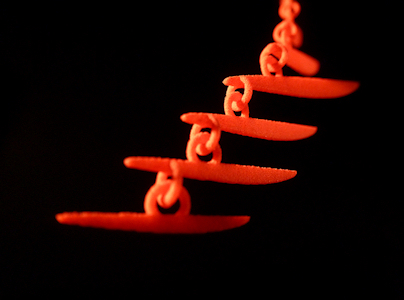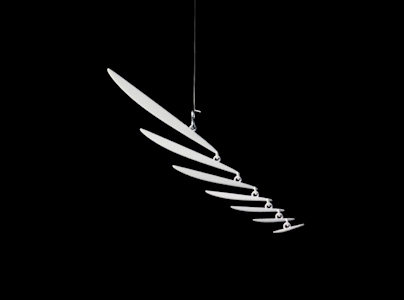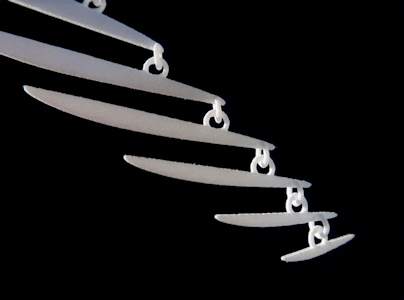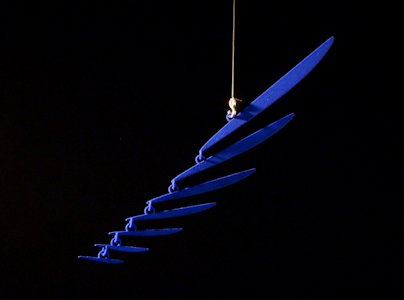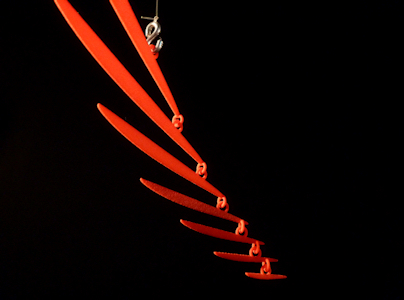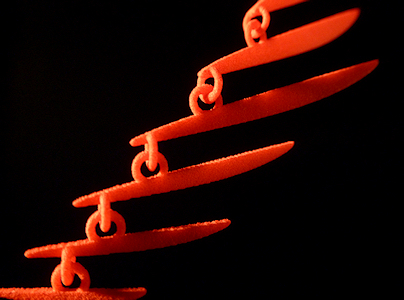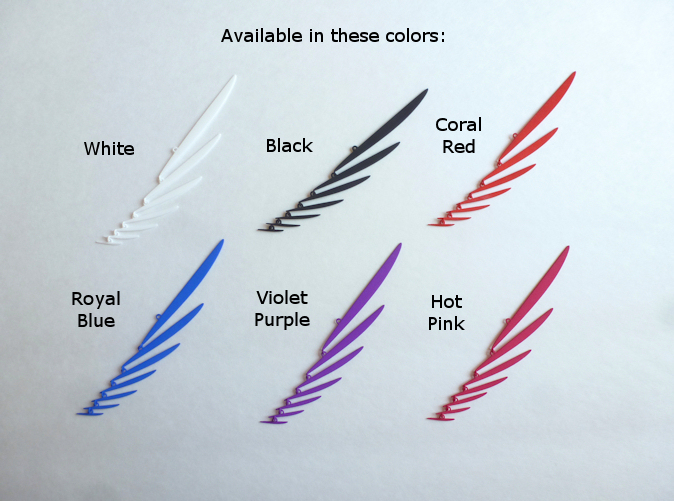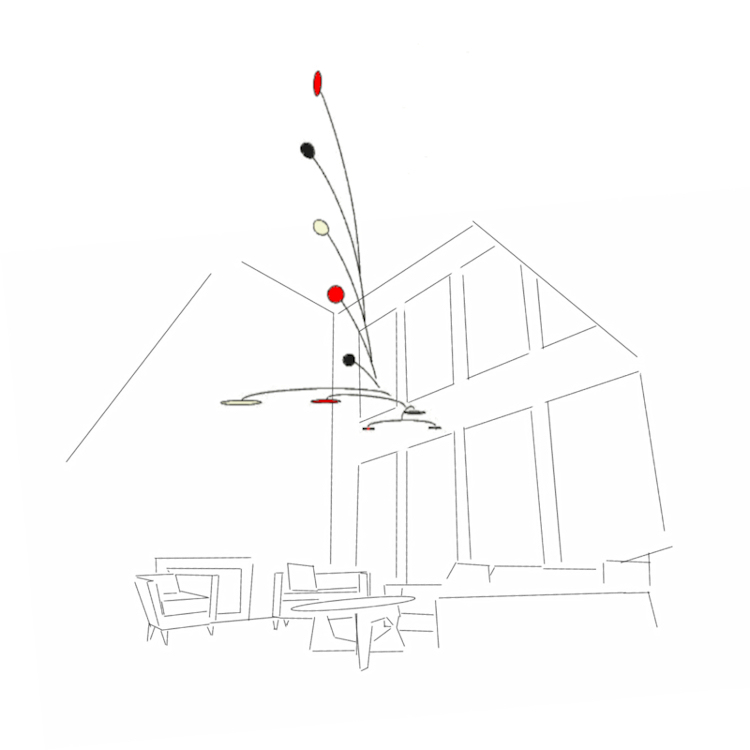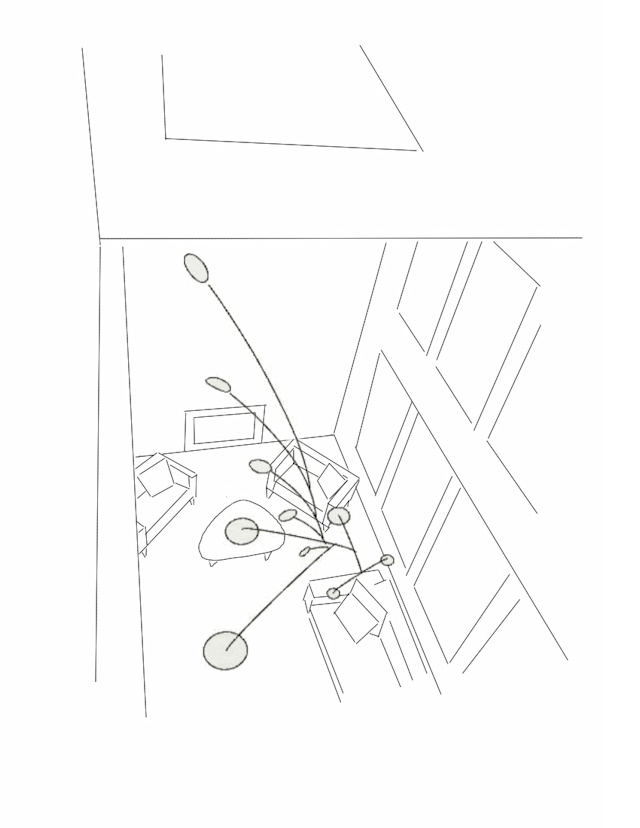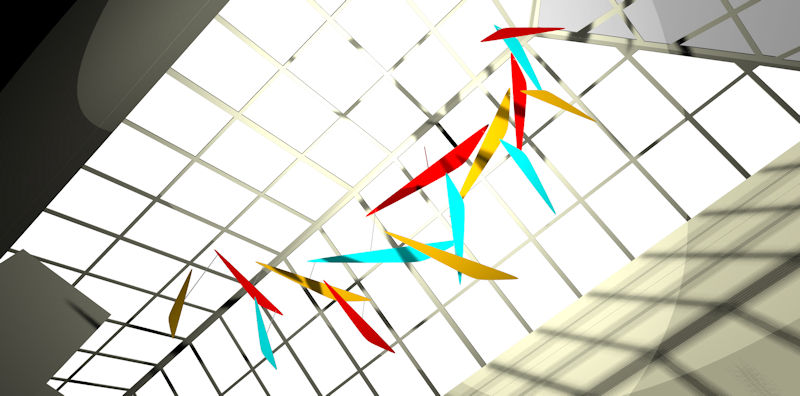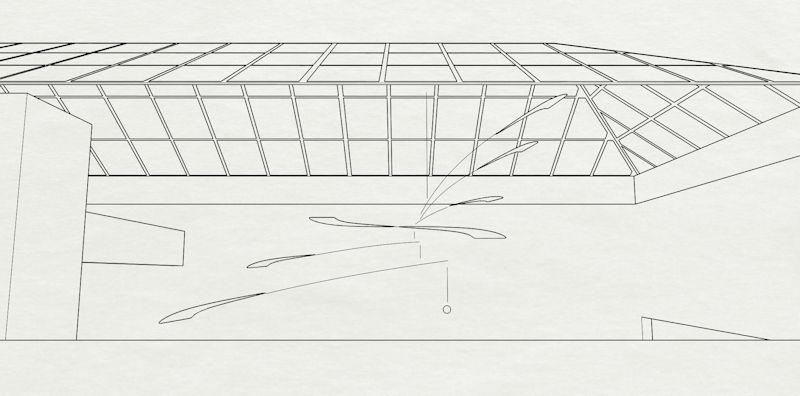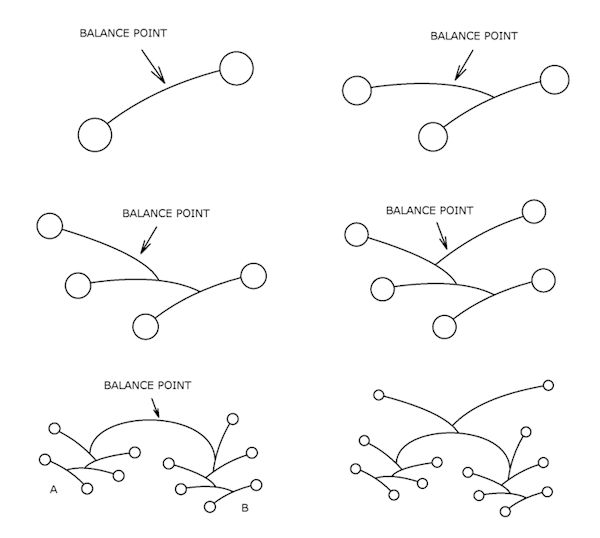3D Printed Holiday Ornament Mobiles
I just dropped of 30 red and white 3D printed holiday ornament mobiles at Modern Artifacts here in Richmond today. For the out-of-towners, you can order them through our shop at Shapeways. Starting at only $9 a piece, they’re also a very affordable mid-century modern meets contemporary 3d printing art gift. And they’re small enough to serve as stocking stuffers.
Now available in 9 different colors (yellow, green and orange are newly added). To have them delivered by Christmas, please order them latest by December 10th if you’re in the U.S. or Europe, for anywhere else it’s December 6th.
This mobile is also featured in “Printing Things – Visions and Essentials for 3D Printing“.
Also see our 3D Printed Quaternary Tree Mobile (Level 4) in the Shapeways Gift Guide in “Conversation Starters” and in “Home Decor”.
Etsy’s Industrial Revolution – What is “handmade”?
The New York Times had an article yesterday called “Etsy’s Industrial Revolution” by Elizabeth Wayland Barber. If you’re not familiar with Etsy, it’s an e-commerce website focused on handmade or vintage items, as well as art and craft supplies. It has 30 million registered users and over US$1 billion in total annual transactions. Here are their latest statistics.
Last month, Etsy announced new policies that would allow sellers to apply to peddle items they produced with manufacturing partners, as well as to hire staff and use outside companies to ship their goods — all provided that the sellers demonstrated the “authorship, responsibility and transparency” intrinsic to handmade items. By easing the definition of “handmade,” Etsy is trying to accommodate individual vendors who are having more and more trouble keeping up with their growing volume of customers. But many Etsy users are outraged by what they see as Etsy’s abandonment of its commitment to human handicraft, with some jumping ship for purer artisan sites like Zibbet.
When is something truly “handmade”? If you make something by hand out of supplies bought at your local craft or hardware store that were made using machines, well then it isn’t 100% handmade. Along those lines, the New York Times article makes the point that almost nothing has been truly handmade for thousands of years. But the real issue that Etsy and both its sellers and buyers are facing I thought was very well summoned up in the comments section:
“The “my handmade is more handmade than your handmade” debate has waged since Etsy first opened. But THIS isn’t not about degrees of handmade. This isn’t about “Hey, Sarah’s shop is handmade because she hand sews every stitch of her handbags while Betty’s shop isn’t because she uses a sewing machine”. This is about Sarah (who stitches everything by hand and charges a price that justifies that time) & Betty (who charges a bit less because her labor is a bit less) both being put out of business because Lulu who is actually a factory with 900 employees is mass producing handbags & selling them as “handmade” on Etsy next to Sarah and Betty’s, charging 1/2 the price. Also: Lulu’s able to produce 2000 new listings a month while Sarah & Betty can only do a few dozen, making their work unfindable. It’s about Cora, who isn’t making ANYTHING. She’s buying bags wholesale dirt cheap on AliExpress & merely reselling the already finished goods that she had NO part of making on Etsy as “handmade” at a fraction of the price Sarah & Betty can. Even before Etsy’s change in policy, you’d find several Lulus & Coras for every Sara or Betty. For Etsy to be transparent, they’d have to be able to tell Sarah’s handmade bags from Cora’s not-even-remotely handmade handbags, a task which they seem unable or unwilling to handle. It’s a masquerade ball & instead of actually investigating who is under the masks, they send out more invitations.” – by “Artist” from “Angryville”. As someone who makes handmade mobiles through a shop on Etsy, this is obviously a topic that concerns me too.
The second issue, and probably the the more contemporary one that wasn’t addressed at all in the article, is Etsy’s policy regarding “handmade” and 3d printing. I sell our collection of 3d printed mobiles through my shop on Etsy. They do allow it (“3D printed items can be sold in the handmade category without listing the manufacturer.” – from their Seller Guidelines). I designed them with the help of Henry Segerman, a mathematician, and we have a 3d printing service company called Shapeways print them for us. We do have a very significant part in creating these mobiles, they are 100% the product of our imagination and creativity. But they are anything but “handmade”.
3D printing aside, if you’re looking to buy something handmade, please make sure it really is handmade and listed by an honest seller. Don’t fall for the cheap pretend handmade stuff. There are a lot of honest hardworking people listing their beautiful and carefully handmade items on Etsy who will very much appreciate your business.
3D Printed Mobiles – Order by these dates for December 24th delivery
For those of you planning on ordering our 3d printed mobiles as holiday gifts, here are the dates you need to order them by the absolute latest to get them in time for Christmas (dates are based on the overnight shipping option):
USA & Europe: December 10th
Anywhere else: December 6th
Starting at just $10, available at our Shapeways shop.
Design for a large custom mobile for a private residence
Design for a large custom mobile for a private residence:
Influenced by Alexander Calder‘s style, yet it has a clear and solid identity of its own.
See more of my custom-designed and custom-made mobiles …
Questions and Answers regarding How to Make Mobiles
Following are some of the questions that I receive via email regarding making mobiles and my answers:
Q: I’ve purchase my wire, but had a hard time finding the correct swivels at my local hobby shop. Is there somewhere in particular I can order them from?
A: I use fishing swivels, which you can get at most stores that sell outdoor sports equipment. They come in a wide variety of designs and sizes, small ones for lake and stream fishing, but also very strong ones for ocean fishing that can carry loads of over 100 pounds (50kg).
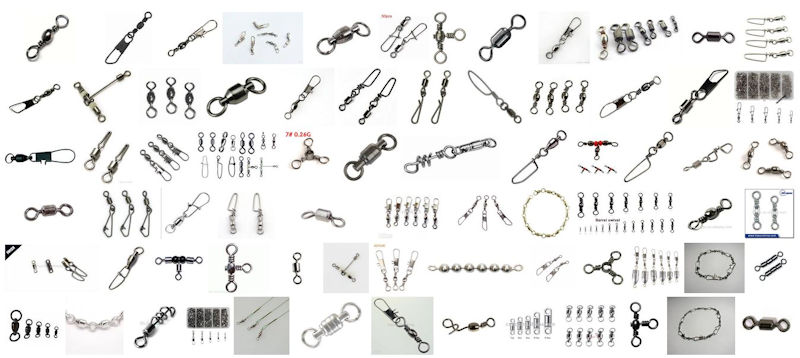
Q: Everything I have researched recommends beginning with the bottom-most arm and building upwards, finding balance points as you go. I’m assuming this means that each connection point all the way up the mobile will perfectly balance all the arms beneath it. Is that correct? So my question is, would it work to deliberately throw the balance off on the lower arms so that you could correct in the opposite direction as you build up? In other words, ignore determining balance points for the first few arms and then make up for the lack of balance in subsequent arms.
A: The balance of the arms are not connected to each other in a direct way, meaning the balance of an upper piece does not change the balance of the lower pieces. For example, the fifth piece from the bottom doesn’t care about whether the lower four pieces are balanced or not. Those four lower piece are just weight that’s attached to the end of the arm of the fifth piece, and that weight stays the same whether the four lower pieces are balanced or not. So no, your idea would not work, at least not with any mobile structures that I know of.
Q: I have made several mobiles with Glass, Copper, and Aluminum. Most are indoors. What wire would you suggest for an outdoor mobile with Aluminum sheet metal (tennis ball container tops) disks,…other than aluminum? I want something with a little more spring to it than the aluminum wire. Would small gauge Stainless Steel be OK. And would it be cost prohibitive, since almost everything I use is recycled or scrap.
A: I would use galvanized steel wire. It has a protective zinc coating that prevents rusting. I’ve had mobiles with galvanized steel wire outside for a long time and they didn’t rust. If you want to make very sure it won’t rust, maybe (spray) paint the wire? The wire should be springy if it’s thick enough. Galvanized steel wire is quite cheap. You should be able to get it at your local hardware store.
Q: I read your article regarding wires. It really helps. How do you make a beautiful curve and keep it curved? (Doesn’t the wire try to go back to straight?)
A: I curve the wire by hand. When you first start out, it might take you a little while to get it shaped the way you want it. With some practice you’ll get more efficient. To make small loops or hooks I use needle-nose pliers. Unless you’re using very thin wire, it will not bend back.
Q: I am thinking to use 3 or 4 small blocks (maybe 2″ high max) of balsa wood, which is very light. Which gauge of wire do you recommend? I feel that 18 is too thin for that?
A: 18 gauge might be a little too thin to attach 2″ balsa wood blocks to. It also depends on the layout of the mobile. If for example, you’re planning on attaching the blocks to the ends of long stretched out wire pieces, 18 gauge most likely would be too thin. If you’re planning on attaching the blocks to the ends of short curved wire pieces, 18 gauge might be thick enough. I think with 16 gauge you would probably be safe either way. Maybe get one roll of each gauge and experiment?
Q: I’m just curious. How do you work when you’re making mobiles? Do you have a hook or something to hang the ongoing project? It would be hard to work on your desk, wouldn’t it?
A: Yes, when working on a mobile, I hang it from a hook. When I make a new piece, I take the mobile off the hook, attach the new piece to it, and put it back on the hook. If it looks good, I move on to making the next piece.
Q: Where can i find a selection of pre-made wire mobiles so that all I have to do is attach apples made of assorted materials from wood to marble to silk to silver?
A: I don’t think anything like what you’re looking for exists. Mobiles work with balance, so the wire structure of the mobile has to be made so it works with the specific weight of the objects attached, meaning you couldn’t just attach random objects or the balance would be thrown off.
Q: What technique do you use to straighten steel wire from a coil? I can already do this, but I was wondering if there was a more effective or efficient method. Also, do you use an Eastman HotCoat to paint your weights? I’m just wondering how you can be so prolific with your mobiles. It takes me hours to make just one!
A: I cut off a piece of wire and then straighten it out and shape it by hand. The way I do it is, I hold one end of the piece of wire with one hand, and I pull away towards the other end of the wire with my other hand with my thumb extended pushing down onto the wire as I glide over it (you sort of run your thumb over the bended wire). Every time I do that, the wire straightens out (or bends) a little more. I don’t know if this makes enough sense. A video would do better … quick YouTube search … this lady here does something similar to what I do. Her approach works fine with thin wire. What I do differently is, I push down onto the wire with my thumb instead and pull away with my thumb pointing towards my other hand. It gives me a little more control and it’s easier on my fingers than the way she does it. Someone told me they’ve used a drill to sort of unwind a roll of wire. I’ve never tried but he said it worked great. I don’t paint the weights. If by weights you mean the metal shapes, there’s a variety of options from spray paint to paint applied with a brush to having it powder coated. It takes me hours too to make one. The big ones can take days or even weeks for a really large custom mobile.
Q: I want to try my hand at building a large-scale mobile for my uncle’s house, which has an extremely high ceiling. I’m guessing steel wire, even at 12 or 9 gauges isn’t going to work anymore. What material do you use to connect the shapes on your larger mobiles (ones that may go over 20 lbs), and where can you get them? I tried checking home depot for aluminum tubes, but no luck.
A: I use aluminum rods (also called rounds). To keep the mobile as light as possible, I would use aluminum instead of steel, for both the rods and the sheet metal. See if there’s a metal retailer in your area, something like Metal Supermarkets. Unless you’re making something really large, I doubt you’ll end up going over 20 lbs. I’m always surprised how light the larger mobiles turn out when I ship them.
Q: I am trying to make a small, multiple level, lightweight metal kinetic mobile with hanging anodized aluminum pieces. What is the best material to use for the horizontal metal components from which I will hang my aluminum pieces? I have seen music wire and aluminum rods. It seems like I should be able to buy some straight pieces that I will cut to size and then bend at both ends as opposed to wire on a coil that I would have to straighten. It appears that 18 gauge wire would be an appropriate size for a small, lightweight beginning mobile. Do you have any suggestions? What is the material that I should be looking for?
A: I’ve always bought wire in rolls. I cut off pieces and straighten them by hand. With a little practice, it’s actually quite easy to do. I haven’t seen straight pieces available in the stores where I usually buy wire. I’ve seem them available on McMaster-Carr but I think the longest straight pieces they have are only 1 foot long. I would give it a try with 18 gauge for your project. It works for light weight attachments and is quite easy to bend. The choice of material is really up to. Steel is usually the cheapest and therefor maybe the best to experiment with as you start out. Galvanized steel has a protective zinc coating that prevents rusting. Some craft stores sell some of the fancier and shinier wires.
Q: My first few mobiles were made from origami – modular geometric origami pieces. But now I’m interested in using metal. I bought a roll of aluminum from a hardware store – one foot by ten feet. The gauge was not listed on the label, but it is pretty thin. I’d guess 18 gauge. I also bought some shears, and got to work. The aluminum is easy to cut. But the shears leave a “serrated” texture along the edge. I tried using a flat file, and that worked OK, but not on concave edges. So my questions are: do you use a file and / or sandpaper on the edges of the aluminum pieces? If a file, what kind(s)? If sandpaper, which grit? Regarding shears: what kind do you find works best? I bought some with really short blades, thinking they would be easier for making detailed curves. I also found a steel / metal retailer that sells 4 foot by 8 foot aluminum sheets, in gauges from 18-11. I’m kind of thinking these might be the way to go because they’re already flat (the roll I bought needs to be flattened, and I couldn’t quite get the pieces perfectly flat).
A: I do sand the edges of the pieces after I cut them out. I have one of those stationary tabletop disc / belt sanders that I use a lot. I lets me shape the pieces very precisely and at the same time gets the job done quickly. I currently have a 120 grit on it. I haven’t found a perfect solution regarding snips and shears leaving marks yet either. I’ve tried both, serrated ones and ones with plain blades. I have one serrated pair that I use a lot similar to this one. It’s probably not the best one for the job, it does leave some marks (that I sand off), but I just really like they way it cuts and feels and it has lasted me forever. It’s more of a personal attachment thing. I buy flat sheet metal.
Q: What is the thickness of the sheet metal you use?
A: The thickness of the metal depends on the design and size of the mobile you have in mind. I would recommend getting some thin sheet metal that’s easy to cut with a pair of shears or snips at your local hardware store to start with. If you’ve never made a mobile before, maybe you want to experiment making a couple out of something easier and quicker than sheet metal, just to get the hang of it.
Q: How do you attach the wire to the sheet metal shapes, looks like it’s welded or soldered?
A: For a smaller mobile, I would just drill two holes into the metal shape and attach the wire with a loop through the two holes (see photos and illustration). For larger mobiles I suggest attaching the shapes with rivets. I would use welding only for something really large.
Q: I just saw the Calder exhibit at LACMA here in LA, the exhibit was designed by Frank Gehry, it’s a remarkable exhibit. I was floored. I’ve been a Calder fan for most of my life but for some reason seeing this exhibit inspired me to try making my own mobiles. Your various articles have been very helpful so far. At Home Depot today I got some 14 & 16 gauge galvanized wire, then I looked at metal for shapes, I couldn’t make up my mind between tin or aluminum. I went with tin and I think it might be a mistake. I bought tin shingles, the aluminum they had was about the same thickness but it bent much easier so I thought the sturdiness of the tin was better. I think the tin is too heavy and difficult to cut. So I wanted to ask your advice. Do you use aluminum? Did Calder use aluminum for his petal shapes?
A: For smaller mobiles I mostly use steel. For larger ones, I sometimes use aluminum. Brass is another good and beautiful option, although more expensive. I think Calder used mostly steel. As much as I know, aluminum wasn’t used that much in general in those days. During the 2nd World War when many types of metals were scarce I think he used whatever he could find.
Q: I recently made a mobile for my uncle who lives in Arizona, but can’t figure out how to ship something as fragile as a wire mobile without dis-assembling it. How do you transport your mobiles to your customers/clients in one piece while making it hassle-free for them to install it out of the box without tangling/assembly issues?
A: With the exception of really large custom mobiles, I ship all mobiles fully assembled. I fold the mobiles so they are as small and flat as possible. I keep the top part of the mobile on top and have a string attached to it already. That way the mobile can be just lifted out of the box by the string. Then I buy flat cardboard sheets (Uline has them) and make custom sized boxes that are just slightly bigger than the folded mobiles. I line the inside of the boxes with one-side-stick bubble wrap sheets and wrap the shapes (paddles) of the mobiles in bubble wrap. Then I fill the rest of the space in the box with packing material (air filled bags, packing peanuts, etc) as tightly as possible without bending the mobile out of shape. I put a few bright orange “Fragile! Handle With Care” stickers on the outside of the box. That’s about it. As far as I know, with having shipped hundreds of mobiles at this point, I’ve had two boxes arriving damaged by USPS, none by UPS.
Q: Many of Calder‘s mobiles appear to hang almost perfectly with each mobile arm vertically aligned. I have been experimenting with some small scale mobiles (pieces made of acrylic and wires up to 0.04″). While I seem able to control general alignment, getting the mobile to hang in good vertical alignment seems impossible. Any tips on this or are many mobiles photographed against a wall? Does this become easier as the mobiles become larger and/or with heavier wire or tubing?
A: I’ve experimented with the shapes of the wire loops, round loops versus more pointy “V” shaped loops, to get the arms to align the way I’d like them to. Sometimes I also adjust the orientation of the loops after assembling the mobile. While that helps to some extend, the arms do keep moving freely and individually to some extend, which on the flip side is part of what makes a mobile a unique and fascinating art form. Heavier mobiles move less because they’re less susceptible to air currents. For the design of a mobile to be easily comprehensible in a 2 dimensional photo, it does help to align the arms vertically. I don’t know if this was done intentionally with Calder’s mobiles, but I usually do try to get at least one or two photos of my mobiles showing off the design with the arms aligned in a flat 2 dimensional way if possible. I don’t photograph them against a wall. I just keep giving the arms a gentle push here and there, or just blow at them a little here and there to get them to align, and keep taking photos. I usually take many more than I need to, and sort out the alignments I think look best on my computer later on.
Q: Do you believe someone can make a living making and selling mobiles?
A: The short answer: it is possible to make a living making and selling mobiles but it isn’t easy. The longer answer: Like any small business, it takes time to set it up, and time to get it going. You have to figure out how to make the mobiles, ideally you’d make something a little different than the competition or at the least beat them in price, you have to take great photos of the mobiles, you have to list them on various online sites and/or find galleries or stores to carry your mobiles and/or show them at art fairs, etc, then you have to figure out how to pack them (they’re fragile), etc. There isn’t a lot of competition with making mobiles but the ones that do it full-time are quite good at it. That said, there’s always people who have a space suitable for a mobile, it just doesn’t cross their minds. So I think there’s always untapped markets to reach out to. I think it’s really a personal decision, just like with starting any other small business, do you think you have what it takes to keep working at it day after day until (hopefully) it turns profitable.
Q: Once you’ve got the balance point, you have to bend a loop into the wire. Doesn’t this mess up the balance point? How do you then compensate…by bending, adding weights or something else?
A: That’s a very good question. When I bend a loop, I try to do it so that I use wire for the loop from both sides of the loop. In other words, I don’t just bend one end of the wire into a loop, I wrap both ends. If you have a balance point that is exactly in the middle of an arm, you would wrap both ends by a 180 degrees to make a loop. If one end of the arm is shorter, you’d want to wrap that end a little less than the longer end to still keep the balance point in the same spot.
I’ll add more of these questions and answers from my email archive when I get a chance.
Joe Murphy sent me a link to a video of the first mobile that he made with dragonflies made of glass after reading some of my how-to posts:
Additional resources on making mobiles:
- Blog post I wrote explaining some of the basics about the balance of a hanging mobile
- Blog post I wrote about What Wire to Use to Make a Hanging Mobile and Where to Buy It
- An article I wrote for MAKE magazine on How to Make a Mobile Based on Calder’s Mobiles
- An article I wrote for Houzz: From the Artist: How to Make a Real Mobile – It’s All in the Balancing Points (there’s a number of questions and answers in the comment section of the article as well). The article is now also available in German
- A history of early mobiles that I’ve put together
- Some technical (“behind-the-scenes”) aspects of designing, making and installing a large custom mobile
- A definition of mobiles
- Q&A about Mobiles for a middle school student’s math class project
- See some of my mobiles if you’re looking for design ideas: handmade mobiles, large custom-made mobiles, 3D printed mobiles and kinetic sculptures

